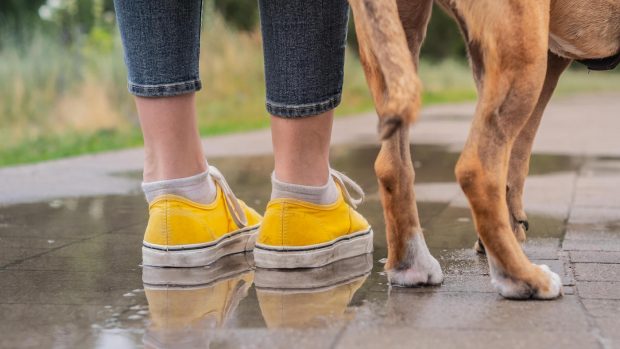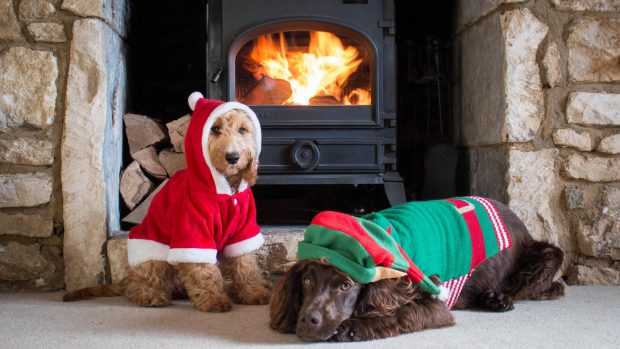Dogs whine for a number of reasons and the noise is usually pretty painful – depending on the whine it’s usually either because you can’t bear it or because the noise breaks your heart, but either way you want to know how to stop a dog whining. Reasons for whining include pain, fear, anxiety anticipation, attention seeking or giving a warning. Knowing what a whine is related to, how to correct it and deal with it in a positive way – without undoing a dog’s natural instinct – needs looking at carefully.
Remember that a dog’s vocalisations are their way of communicating. Whining is especially common in puppies because they’re learning how to communicate their needs and wants. Young puppies whine to get attention and food from their mother in the same way that babies cry.
Stress and anxiety whining
It’s common for a dog to whine when he’s anxious or afraid. This type of whining is often accompanied by other body language, known as appeasement gestures, such as yawning, lip licking or averting the eyes. You may also notice a whine and yawn occurring together. By displaying appeasement gestures, the dog is trying to calm itself down and send a signal to others that it’s not a threat.
If your dog is whining due to stress, they may also be cowering, have flattened ears and a tucked tail. It will also be accompanied by behaviours such as pacing, shaking, destructiveness, panting, and fight or flight syndrome.
How to stop a dog whining due to stress and anxiety whining
To help a dog with anxiety, try to identify the reason for the stress – that way you can either remove it if possible or provide your dog with a safe place that they are more comfortable in and able to cope, such their dog crate if they are crate trained.
If the whining is due to separation anxiety, you can desensitise your dog to things they get stressed about. For example, you can get your dog used to you leaving by showing them every time you pick up keys or your coat that you aren’t always leaving. This will mean they are less stressed in the run-up to your departure. Where possible do not always leave by the same exit. You could also leave them for short periods and build up the time gradually, as well as leave music on, provide them with enrichment in the form of a puzzle toy or lick mat (like this one on Amazon), along with something that smells of you.
What not to do
As frustrating as you may find the whining, avoid shouting at your dog. Never use punishment or harsh words to try and correct the behaviour. This can make your dog feel stressed and more fearful and could result in an aggressive reaction or an increase in anxiety, including toileting in the house or fear urination.

Adaptil Calming Spray | Amazon.co.uk
This spray contains a synthetic copy of the “dog appeasing pheromone”, which a mother naturally releases to calm and reassure her litter.

LickiMat Soother | Amazon.co.uk
This mat helps calm and soothe your pet by helping release endorphins by promoting licking.
Alert and excitement whining
Whining accompanied by running around, a wagging tail and jumping up could indicate your dog is excited. This type of whining links to attention-seeking behaviour because your dog is looking for an acknowledgment, such as a pat on the head or to be made a fuss of. This is perfectly normal and what a wonderful place the world would be if everyone was this enthusiastic when they saw us. It’s a way for them to express their happiness at seeing their best friend – you!
Sometimes dogs will whine if they are alerting us to something that is wrong or that they’re fearful. There have been numerous stories of dogs whining and nudging their owners before medical episodes occur. Some dogs whine before a storm or if they can see or smell someone they fear.
How to help and stop this whining
In the instance of over-excitedness, begin teaching the “off” command if your dog jumps up and find something to put in his mouths to redirect the behaviour. One of my dearest client’s dogs, Lottie the German Shepherd, was a nightmare for this but we overcame it by not engaging her until I taught her to find something to hold before I would stroke her. She still vocalised to a degree but after the initial stroke, I would ask her to do other things to engage her brain, such as “look at me” while fussing her or teaching her to come through the middle of my legs and get a fuss – while still holding any object she could find. This occupied her mind, stopped her behaviour and we both got the cuddles without the noise.
With regard to alert behaviour, you need to seek out wherever possible what it is that the dog is alerting you to. I appreciate in the event of a medical episode this will not always be possible. However, in the event of alerting us to either impending danger or someone they are unsure of, it’s important that we control the environment for them and remove that fear by dealing with the problem. In the case of a storm, we can lead them to their safe area, which may be under the bed – and stay with them if necessary. In the case of a person or a dog they do not like, we can block them from the person or dog, or remove the dog from the situation wherever possible.
What not to do
Do not shout or punish the dog. Teach new commands, redirect the focus and control the the situation, surroundings and their environment to the best of your ability so as to alleviate the response and the emotion that they are struggling with.
Whining for attention
If your dog’s whining accompanies your mealtime, chances are they want a tasty morsel from your plate. Appeasing this behaviour and feeding your dog from the table is not the way to stop it and can be a habit that is difficult to break. A dog who whines could also be using their powers of manipulation to get your attention. They might be after a walk, a meal or some affection.
On the other hand, your dog could be alerting you to their need for a toilet break. In that case, the whining is effective communication that can be easily solved by taking them outside to toilet to see if this is the case. Sometimes dogs whine just because no one is paying attention to them. This is similar to young children whining when they’re bored with the grown-up talk at dinner or are fed up while doing the weekly shop.
How to stop a dog whining for attention
Make sure your dog has enough enrichment, is being exercised plenty and fed the right food – too much sugar or caffeine builds up as excess energy that needs releasing.
Make sure you’re not rewarding attention-seeking behaviour. Some dogs are sharp cookies and if they learn to bark, then stop on a command such as “quiet” and they then get a treat every time, more often than not they will display the behaviour in order to get the reward. This is known as learned behaviour and is manipulation of their owner at its finest. I like to tell my clients: “Remember, we do not negotiate with terrorists”.
What not to do
Again, don’t shout and avoid eye contact while correcting with the “quiet” command. When the whining stops, give the “yes” command for affirmation, and do this together with direct eye contact and a stroke.
Whining due to pain
This is a fairly obvious one and usually easy to spot – a dog in discomfort will often cry out and omit a low continuous whine. This can build up to a crescendo and often happens after an anaesthetic when they are coming round and maybe disorientated or feeling extreme discomfort.
Whining accompanied by limping or licking could be a sign that your dog is in pain. If handling your dog makes them whine, this could also be indicative of an injury or internal discomfort. In this case, the whining is necessary and your dog is trying to communicate that he’s hurting and needs your help. Dogs are notorious for hiding their pain, so if the situation has progressed to vocalisations, you should get an appointment with your vet as soon as possible to find the underlying cause of your dog’s discomfort.
How to help a dog whining in pain
Try to find locate the source of the pain. It could be something as simple as a thorn in a pad, which you can remove. If you can’t see a physical injury, check if your dog has a temperature, is being sick, lethargic, has diarrhoea or excessively drooling. In any of these events, you need to go straight to the vet.
You must also be wary if your best friend is in pain, as pain can make reactions different than normal both in dogs and humans. A very gentle loving dog can still lash out at their owners if in pain so handling correctly is extremely important.
What not to do
Do not leave them in distress as clearly they are suffering. If it’s something you cannot cure or solve, then do not hesitate in taking the dog to the vets as soon as possible. Do not punish or chastise them for communicating their discomfort to us in the only way they know how.
Whining to ask for something
Quite often my mastiffs whine when one or the other is lying in the way of somewhere they want to go. This alerts me to get the said mastiff to move and allow the other one access to their bed or the water bowl. They can whine if they need water, the toilet or there is a toy just out of their reach under furniture.
How to help
The most important thing you can do as an owner is understand the different sounds of their whining as a parent would with a crying baby. For instance, I know my dog’s “I feel needy” whine from his “I need to toilet whine” and his “my sister is in the way” whine. Understanding what they’re expressing and helping them usually stops the behaviour instantly.
However, if your dog is whining because they want you to stroke them or you’re engaging with another dog, this must be stopped and redirected. Generally, I do this by removing eye contact and walking away to do something else. I also won’t acknowledge my dogs at all if they are whining while I stroke another dog. Only when it stops will I say “yes” as affirmation and then stroke them, too. It all depends on the whine as to how fast you would respond.
What not to do
Do not scold, reprimand, shout or smack your dog. Try to sort out the problem if possible, such as retrieving a toy out of reach, replacing their water or helping move another dog out of their way to avoid a confrontation. Avoid running over straight away in other circumstances where your attention is not required instantly and give your dog time to sort out the dilemma wherever possible. If you don’t, the dog will condition you to come running every time he barks or whines.
You might also like:

No more yapping: how to stop a dog nuisance barking

How to help an anxious dog

Best dog crates: a safe haven for the home and the car

Subscribe to Horse & Hound magazine today – and enjoy unlimited website access all year round
Horse & Hound magazine, out every Thursday, is packed with all the latest news and reports, as well as interviews, specials, nostalgia, vet and training advice. Find how you can enjoy the magazine delivered to your door every week, plus options to upgrade your subscription to access our online service that brings you breaking news and reports as well as other benefits.




